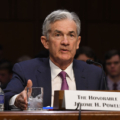The Interest Rate Puzzle
The financial markets swooned in January in response to the statements and growing perceptions that central banks must soon begin the painful task of slowing inflation. The old saw on Wall Street is, “as goes January, so goes the year.” If so, we are in for a very volatile year.
The irony is, of course, it was those very central banks by their own actions, and their politically motivated maneuvering, which freed legislators around the world from the painful tasks of keeping a rational budget. If markets had to absorb all the debt created by governments, and if that debt were not purchased by central banks, rates would already be higher than they are now.
As it is, the bellwether 10 year US Treasury yield has swiftly moved up about a half percent in the past months or so, even before the Federal Reserve has officially started tightening.
This is a product of bipartisan failure. One of the serious deficiencies of the Trump Administration is he did not deal squarely with the deficit issue when he had the opportunity. In his defense, it has been quite some time since the Republican Party was the party of fiscal rectitude and sound money. We are not sure even today if those attitudes are all that prevalent even among those who support the MAGA agenda.
To be sure, the Covid crisis added some momentum to the already accelerating debt problem, but Democrats seized on the crisis to ram through additional programs which had little to do with Covid relief. It had more to do with their socialist agenda. Now we have a national debt crossing above $30 Trillion.
And it was a choice, largely accepted by both parties to address the Covid crisis through lockdowns, which created economic turmoil. We now know, based on the recent study released by Johns Hopkins, that we suffered grave economic damage with very little to show in terms of reduced mortality. It is true though, that Republicans were earlier to move away from lockdown while Democrat-dominated areas still embrace the concept.
Further, many other nations copied the lockdown modality and some like China, Germany, Austria, Australia, and New Zealand went even further than the US.
Like other sectors of society, we did not understand at first exactly what we were facing when the Chinese virus hit our shores. But at The Prickly Pear, we always mentioned we were opposed to lockdowns measures because we felt it was ignorant of the many trade-offs and was anti-democratic to its core. We think the Johns Hopkins study recently released vindicates our position and that of countries like Sweden and American Republican governors and mayors who exercised lockdown with a much lighter touch.
But as they say, “it is what it is.” World leaders chose Fauci’s lockdown and huge bailout spending based on deficit finance. Covid did not do this rather we did it to ourselves. This added huge amounts of debt to an already teetering debt structure built after the 2008 financial crisis bailouts and more socialist programs. Now, we must all face the consequences.
The Economist recently ran a study on what minor increases in interest rates will have on the global economy, given this overhang of debt. They looked at 58 of the world’s largest economies and attempted to derive an estimate of what the global interest bill would be under various interest rate scenarios.
It is important to understand their numbers are based on the very unusual and historically unprecedented condition of not only almost zero interest rates but negative rates on a huge swath of the world’s bonded indebtedness.
At present, the Economist estimates the current interest rate tab to be $10 trillion dollars or about 12% of global GDP. To give you some measure of scale, the total of US output is in the range of $23 trillion.
However, since the global debt burden is now 355% of GDP, and is much larger than it was during the inflation crisis of the 1970s, any incremental increases in rates will have a magnified effect on the economy. The boomerang effect of pushing growth through debt issuance is that the whole debt structure becomes much more sensitive to small changes in rates. They estimate that just a one percent change in rates translates to a jump to a $16 Trillion global interest payment. That is a 60% change from where we are today! A two percent increase in rates pushes the global interest tab to $20 Trillion, a doubling of current costs.
The higher the debt payments, the less money available for investment or consumption. This will prove to be equivalent to the nutritional issues faced by a hungry snake that is swallowing its own tail.
The more debt, the less growth. The less growth, the lower the ability to service the expanding debt.
Moreover, the structure of the welfare state itself magnifies the risk. If the economy slows, less revenue flows to the state, just when more people start making additional claims on welfare state programs such as food stamps, rent subsidies, and unemployment insurance. Thus, fiscal deficits during recession grow and they must be financed by the private sector, by the Fed, or more money printed out of thin air.
As the economy slows, debt may well become unstable, as some marginal borrowers will likely be unable to service interest and principal payments, triggering more welfare state bailouts for “favored” businesses like autos, airlines, and banks.
Interest rates serve like traffic lights, directing the flow of capital. Projects that look favorable under one interest rate do not look the same under another. Economists call this the misallocation of capital. In part, that is what recession does. It corrects errors made during the boom phase. However, if the government constantly intervenes, those misallocations of capital accumulate like the dead under brush in a forest. If enough dry undergrowth is allowed to accumulate, any economic or political spark can set off a conflagration hard to contain.
We are not sure where this leads us since this level of debt and the extremely low-interest rate regime has no real historic precedent. Push rates up to even “normal” historical levels, and the global debt burden soars, sucking more money out of productive activity. But if you don’t push rates higher, inflation can wipe out both the middle and lower classes of society, leading to political instability and perhaps violence. Inflation acts as a compound interest curve in reverse. If inflation were to stay in the present range of 7%, the value of money will fall in half in just 10 years. Try to plan a retirement around that!
It has long been felt by the dominant economics profession, that the free market was unstable and that balanced budgets and a gold standard put governments in a bind to deal with an economic crisis. Better to have large central planning agencies like the Fed and Treasury Department, guiding the economy with the input of giant international corporations. Davos man knows best!
Well, we have had more than a half-century now of depreciating money, chronic budget deficits, and active central planning by government and its “experts.”. As James Grant has put it, we have substituted the Ph.D. standard for the quiet automatic discipline of the gold standard.
The risk now is, central planners have created a situation where either a debt crisis, an inflation crisis, or both, will engulf us.
How far do interest rates need to go to choke off inflation? How high do they go before interest costs undermine growth?
It looks like we will soon find out.



